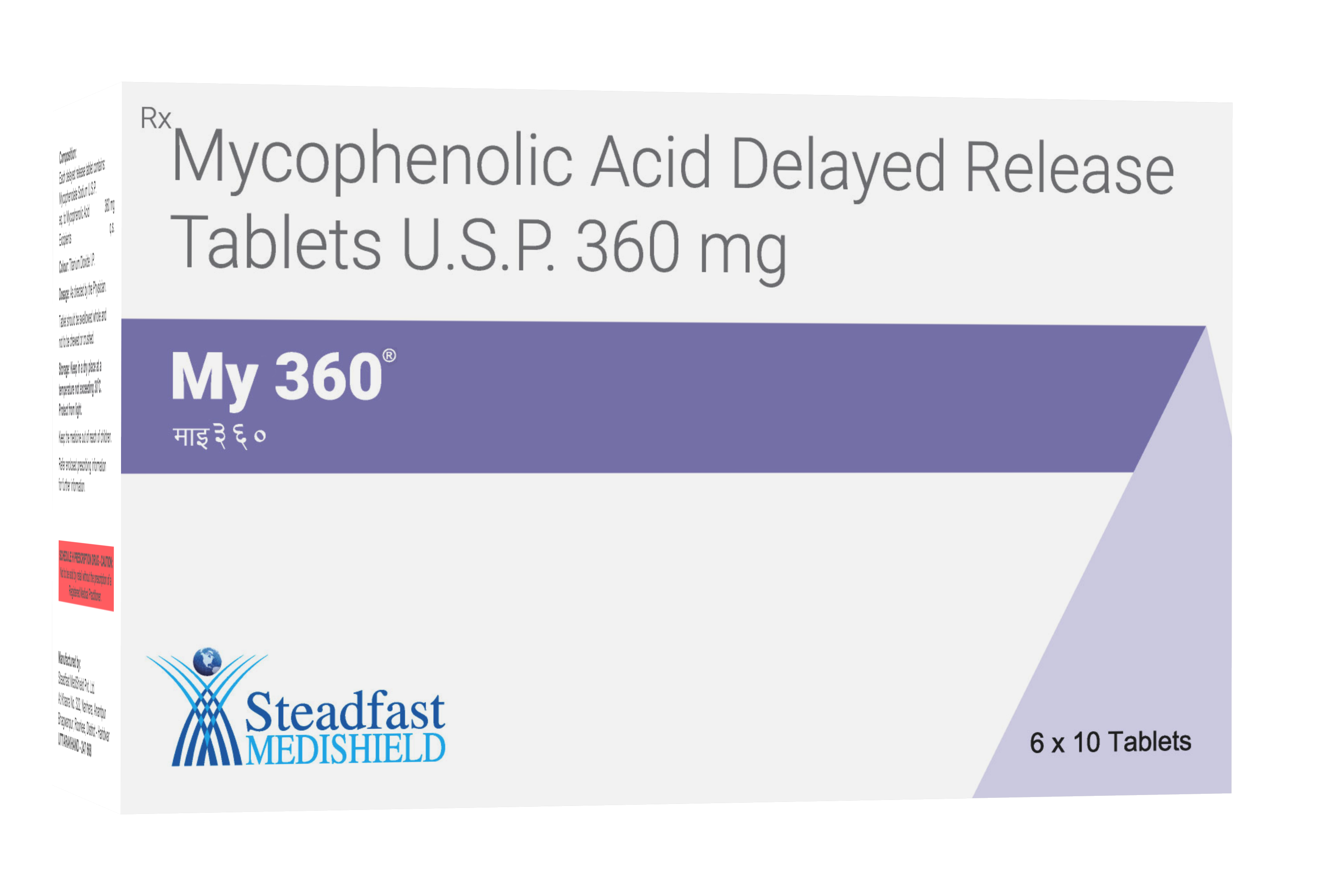
Description
My360 is an enteric formulation of Mycophenolate sodium that delivers the active moiety Mycophenolic acid (MPA). My360 is an immunosuppressant agent. MPA is chemically designated as(E)-6-(4-hydroxy-6-methoxy-7-methyl-3-oxo-1,3-dihydroisobenzofuran-5-yl)-4-methylhex-4-enoic acid sodium salt. Its empirical formula is C17H19O6 Na and molecular weight is 342.32.
Composition
Each film-coated tablet contains enteric coated Mycophenolate Sodium 360 mg.
Mode of Action
The mechanism of action of MPA is based on interference with purine synthesis. It is a reversible, noncompetitive inhibitor of inosine monophosphate dehydrogenase (IMPDH), which is an enzyme that facilitates the conversion of inosine monophosphate (IMP) to xanthosine monophosphate, a precursor of guanine nucleotides. This blocks the de novo synthesis of guanosine nucleotides that are necessary substrates for DNA and RNA synthesis. Unlike other cell types which can use the salvage pathways, B and T lymphocytes are dependent upon the de novo pathway for the generation of guanosine. My360 is designed to reduce the adverse GI events of MPA (in particular nausea, vomiting, dyspepsia and abdominal pain), while allowing more sustained absorption of the MPA delivered to the small intestine.
Pharmacokinetics
Absorption
My360 is extensively absorbed from the GI tract. The protein binding of Mycophenolic acid glucuronide (MPAG) is 82%. The free MPA concentration may increase under conditions of decreased protein binding (uremia, hepatic failure and hypoalbuminemia). Vitro studies demonstrated that the enteric-coated My360 tablet does not release MPA under acidic conditions (pH <5) as in the stomach, but is highly soluble in neutral pH conditions as in the intestine.
Distribution
Mycophenolic acid is 97% bound to plasma proteins. The mean (± SD) volume of distribution at steady state and elimination phase for MPA is 54 (± 25) L and 112 (± 48) L respectively. MPA is highly protein bound to albumin >98%. The protein binding of Mycophenolic acid glucuronide (MPAG) is 82%. The free MPA concentration may increase under conditions of decreased protein binding (uremia, hepatic failure, and hypoalbuminemia).
Metabolism
Mycophenolate is converted to active MPA, which undergoes enterohepatic recirculation. MPA is metabolised by glucuronidation to the inactive glucuronide.
Excretion
Via urine (as the glucuronide and negligible amounts of MPA); via faeces (about 6% of a dose). Mean half-life of MPA: 17.9 hours (as oral Mycophenolate mofetil) and 16.6 hours (as IV Mycophenolate mofetil); 12 hours (as Mycophenolate sodium).
Indication
Mycophenolate Sodium is indicated for the prophylaxis of organ rejection in patients receiving allogenic renal transplants, administered in combination with Cyclosporine and corticosteroids.
Contraindication
My360 is contraindicated in patients with a hypersensitivity to Mycophenolic acid, Mycophenolate mofetil (MMF) or to any of its excipients.
Precautions
Monitoring: Perform complete blood counts weekly during first month of treatment, twice monthly for second and third months, then monthly throughout the first year.
GI hemorrhage: Since Mycophenolate has been associated with an increased incidence of GI adverse events, including infrequent cases of GI tract ulceration, hemorrhage and perforation, administer with caution in patients with active serious GI disease.
Delayed renal graft function post transplant: No dose adjustment is recommended for these patients. However, they should be carefully observed.
Warnings
Pregnancy: There are no adequate and well controlled studies in pregnant women. Do not use in pregnant women unless the potential benefit justifies the potential risk to the fetus.
Lactation: Studies in rats treated with Mycophenolate have shown Mycophenolic acid to be excreted in milk. It is not known whether this drug is excreted in human breast milk. Because of the potential for serious adverse reactions in nursing infants from Mycophenolate, decide whether to discontinue nursing or to discontinue the drug, taking into account the importance of the drug to the mother.
Children: Safety and efficacy have not been established.
Lymphomas/Malignancies: Patients receiving immunosuppressive regimens involving combinations of drugs, including Mycophenolate, are at increased risk of developing lymphomas and other malignancies, particularly of the skin. Over suppression of the immune system can also increase susceptibility to infection.
Neutropenia: Monitor patients receiving Mycophenolate for neutropenia. The development of neutropenia may be related to Mycophenolate itself, concomitant medications, viral infections or some combination of these causes.
Renal function impairment: Avoid Mycophenolate doses >1g twice a day and carefully observe patients.
Adverse Effects
The principal adverse reactions associated with Mycophenolate include diarrhea, leucopenia, sepsis and vomiting as well as evidence of a higher frequency of certain types of infections. Serious life threatening infections such as meningitis and infectious endocarditis have been reported occasionally and there is evidence of a higher frequency of certain types of serious infections such as tuberculosis and atypical mycobacterium infection.
Other adverse reactions occurring in 3% to <20% of patients in combination with Cyclosporine and corticosteroids are as follows:
Cardiovascular: Angina pectoris, arterial fibrillation, hypotension, palpitation, peripheral vascular disorder, postural hypotension, tachycardia, thrombosis, vasodilatation, ventricular extra systole, CHF, supraventricular tachycardia, ventricular tachycardia, arterial flutter, pulmonary hypertension, heart arrest, venous pressure increased, syncope, supraventricular extra systoles, pallor and vasospasm.
CNS: Anxiety, depression, hypertonia, paresthesia, somnolence, emotional liability, neuropathy, convulsion, hallucinations, abnormal thinking and vertigo.
Dermatologic: Alopecia, fungal dermatitis, hirsutism, pruritus, benign skin neoplasm, skin disorder, skin hypertrophy, skin ulcer, sweating, hemorrhage and skin carcinoma.
Endocrine: Diabetes, parathyroid disorder, Cushing’s syndrome and hypothyroidism.
GI: Anorexia, esophagitis, flatulence, gastritis, gastroenteritis, GI hemorrhage, gingivitis, gum hyperplasia, hepatitis, ileus, infection, mouth ulceration, rectal disorder, GI disorder, liver damage, dysphagia, jaundice, stomatitis and thirst.
GU: Albuminuria, dysuria, hydronephrosis, impotence, pain, pyelonephritis, urinary frequency, nocturia, kidney failure, urine abnormality, hematuria, urinary incontinence, prostatic disorder and urinary retention
Musculoskeletal: Arthralgia, joint disorder, leg cramps myalgia and myasthenia.
Respiratory: Asthma, lung edema, pleural effusion, rhinitis, sinusitis, atelectasis, hiccough, pneumothorax, increased sputum, epistaxis, apnea, voice alteration, pain, hemoptysis, neoplasm, respiratory acidosis.
Special sense: Amblyopia, cataract, conjunctivitis, ear pain, deafness, ear disorder, tinnitus, abnormal vision, lacrimation disorder, eye hemorrhage.
Miscellaneous: Abdomen enlarged, chills/fever, cyst, face edema, flu syndrome, hemorrhage, hernia, malaise, pelvic pain, ecchymosis, polycythemia, neck pain, cellulitis, increased prothrombin, decreased thromboplastin, petechia, phlebitis, thrombosis, weight gain/loss, abnormal healing and dehydration.
Lab Test Abnormalities: Increased alkaline phosphates, creatinine, gamma glutamyl transpeptidase, lactic dehydrogenase, AST and ALT, hypercalcemia, hyperlipidemia, hyperuricemia, hypervolemia, hypocalcemia, hypoglycemia, hypoproteinemia, acidosis, hypoxia, hypophosphatemia, alkalosis and hypochloremia.
Drug Interaction
- Drugs that are eliminated by renal tubular secretion (e.g., aciclovir, ganciclovir) have the potential to inhibit the elimination of MPAG through competition for renal tubular secretion
- Agents that interfere with enterohepatic recycling (e.g., bile acid sequestrants, antibiotics) may reduce the amount of Mycophenolic acid available for reabsorption.
Dosage and Administration
Dosage
The recommended dose is 720 mg (four 180 mg or two 360 mg My360 gastro-resistant tablets) administered twice daily (1440 mg daily dose). M360 delayed-release tablets and mycophenolate mofetil tablets and capsules should not be used interchangeably without physician supervision because the rate of absorption following the administration of these two products is not equivalent.
General target population
Treatment with My360 should be initiated and maintained by appropriately qualified transplant specialists.
My360 should be initiated in de-novo patients within 48 hours following transplantation.
My360 can be taken with or without food.
Special populations of Paediatric patients
Safety and efficacy in paediatric patients have not been established. Limited pharmacokinetic data are available for paediatric renal transplant patients
Geriatric patients
No dose adjustment is required in this patient population.
Renal impairment
No dose adjustments are needed in patients experiencing delayed renal graft function post-operatively. Patients with severe chronic renal impairment (glomerular filtration rate 25 mL min-1 • 1.73 m-2 ) should be carefully followed up.
Hepatic impairment
No dose adjustments are needed for renal transplant patients with severe hepatic parenchymal disease.
Treatment during rejection episodes
Renal transplant rejection does not lead to changes in mycophenolic acid pharmacokinetics; dosage reduction or interruption of Mv360 is not required.
Presentation
10 tablets packed in a blister, 6 such blisters packed in a carton
